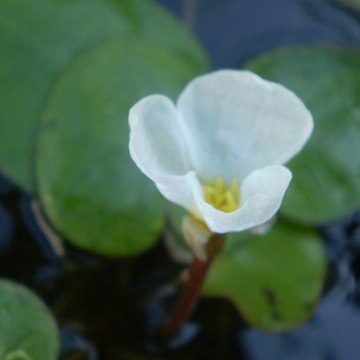Leaves floating or sometimes emerged; blade cordate or orbicular, 4.5-5 × 5-5.5 cm, 5-7-veined, base cordate, apex rounded. Male flowers 5 or 6 in spathe; peduncles 0.5-3.5 cm; pedicels 5-6.5 cm; sepals ca. 6 × 3 mm; petals yellow, ca. 1.3 × 1.7 cm; stamens 12, inner 3 stamens staminodal; anthers 1-1.5 mm; staminodes hairy at base and papillose at apex. Female flowers larger than male flowers; sepals ca. 1.1 cm × 4 mm; petals white, yellow at base, ca. 1.5 × 1.8 cm; staminodes 6; glands 3, reniform; styles ca. 4 mm, with dense glandular hairs. Fruit berrylike, spherical to obovoid, 8-10 mm, ca. 7 mm in diam. Seeds gradually acute toward apex. Fl. and fr. Aug-Oct. 2n = 16.
A plant which grows in water and keeps growing from year to year. It can be free floating or root in mud. It has long creeping runners which are fleshy and branched. The leaves are 3-6 cm long by 3-6 cm wide. They are broadly oval, heart shaped or kidney shaped. The leaf stalks are 5-12 cm long. The leaves can be floating or above the water. They are bright green and shiny. They are spongy. The flowers are 2-3 cm across and white with a yellow centre. The male flowers are in groups of 1-4. The female flowers occur singly. They have longer stalks. The fruit are 5-10 mm long and about 5 mm wide. There are several lumpy seeds. These are 1-1.5 mm long.
Perennial aquatic; stolons rooted in shallow water, floating across deeper water. Leaves emergent and floating; petiole 5–14 cm long, with one median stipule to 3.1 cm long; lamina broadly ovate to ±circular, 2–6 cm long and nearly as wide, cordate to reniform or truncate at base. Spathe 1–2.5 cm long. Flowers aerial, erect, c. 2–3 cm diam. Sepals 4–5 mm long, 2–3 mm wide, green. Petals 10–15 mm long, rounded, white, yellow at very base. Male flowers 1–4, on short pedicels in pedunculate spathe. Female flowers solitary, on pedicel 1–8 cm long in sessile spathe. Fruit 5–10 mm long, about half as wide. Seeds 1–1.5 mm long, tuberculate.


